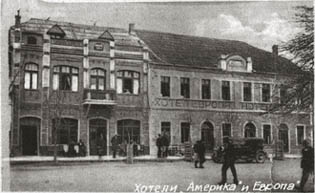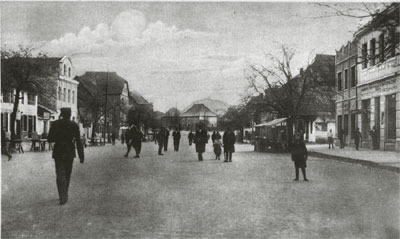|

The
territory of Berane was colonized still in Neolithic period. In this
ancient settlement, the life was going on for about 1500 years - from 4500
to 3000 BC.
A lot of subjects testify about this which was discovered
on the Locality of Berankrs. In a village called Luzac, Roman army's
settlements were discovered with arrows, the tops of spears and the other
weapons. Also the evidences about the life of Illyrian were discovered but
they have not examined yet. In the year 1219 the bishopric of Budimlja was
established there, being later turned into the metropolitan's residence
and Berankrs near Beran village.
 Berane
town founded in 1862 by Turkish conquerors, first on the right bank of the
river Lim and later it developed on the other bank too. First, Turks made
military fortresses and residents for soldiers only, but later the town
developed more and more every day. Two men of that time were particularly
responsible for the look of the town: Rizvan bay Jajcanin and Tahir pasha.
The former has studied the architecture in Paris so he designed the main
street as a French boulevard. It’s very wide with trees on both sides. The
later designed the look of the houses. Trade and manufacturing flourished.
There were many shoe makers, tailors, blacksmiths, arm makers etc. More
and more people have been coming to live in this town. Berane
town founded in 1862 by Turkish conquerors, first on the right bank of the
river Lim and later it developed on the other bank too. First, Turks made
military fortresses and residents for soldiers only, but later the town
developed more and more every day. Two men of that time were particularly
responsible for the look of the town: Rizvan bay Jajcanin and Tahir pasha.
The former has studied the architecture in Paris so he designed the main
street as a French boulevard. It’s very wide with trees on both sides. The
later designed the look of the houses. Trade and manufacturing flourished.
There were many shoe makers, tailors, blacksmiths, arm makers etc. More
and more people have been coming to live in this town.

During Second World War this part of Europe was under the Italian army,
and the situation was very difficult. They decided to begin an uprising
against the enemy, on July 21, 1941 and they liberated the most part of
northern Montenegro, it was the only free land in Europe beside the one in
Serbia. Here, the people of Berane organized the National Liberation
Committee which took over, for the first time, the whole control in the
town.
There are several important cultural and historical monuments in this
region, such as: a medieval town Bihor, which was the headquarters of the
tribal state in the period when Nemanjici ruled, situated at the
confluence of the rivers Lim and Ljesnica; Budimlja, which was built on
the remnants of the former Roman settlement.
Museum Polimski
 Museum
Polimski has very rich collection of priceless exponents. It is situated
in Dom Trezvenosti, the building of National Liberation Committee. The
museum was founded in 1953 and it represents not only Berane municipality
but other towns like Rozaje, Plav and Andrijevica. It is consisted of
three sections: ethnological, historical and archeological. Museum
Polimski has very rich collection of priceless exponents. It is situated
in Dom Trezvenosti, the building of National Liberation Committee. The
museum was founded in 1953 and it represents not only Berane municipality
but other towns like Rozaje, Plav and Andrijevica. It is consisted of
three sections: ethnological, historical and archeological.
Jasikovac
 During
the past centuries people from this part of Montenegro fought for their
freedom and there a lot of history monuments in Berane which testify about
these battles. One of the most important was built on the hill Jasikovac.
The hill provides an excellent view of our town. The monument is situated
on a place of the former Turkish fortress. It was built in 1977. and it
represents the monument of freedom. It is very unusual, it is eighteen
meters high and it has a shape of a cone. The cone represents a bullet
which was shot at all our enslavers and that ‘bullet’ brought us freedom.
But it is not just the cone, forty huge granite blocks were circled around
it. The history of people and town is written on those blocks. During
the past centuries people from this part of Montenegro fought for their
freedom and there a lot of history monuments in Berane which testify about
these battles. One of the most important was built on the hill Jasikovac.
The hill provides an excellent view of our town. The monument is situated
on a place of the former Turkish fortress. It was built in 1977. and it
represents the monument of freedom. It is very unusual, it is eighteen
meters high and it has a shape of a cone. The cone represents a bullet
which was shot at all our enslavers and that ‘bullet’ brought us freedom.
But it is not just the cone, forty huge granite blocks were circled around
it. The history of people and town is written on those blocks.
Monastery ‘Djurdjevi Stupovi’
The monastery was built by the head of the tribal state, Stefan Prvoslav.
It was built on the left side of the river Lim, on the part which is
called Stupovi in the XIII century, on a hill above a small river where
springs cold and clear water. This monastery was full of frescoes which
were describing the scenes from the New Testament.

Duke Gavro Vukovic
 Duke
Gavro Vukovic was the first diplomat in Montenegro. He was born in Lopate,
in 1852. He finished his primary school in monastery Djurdjevi Stupovi,
which confirms the educational value that monastery had for this region.
Later he went to Belgrade to finish Gymnasium and Low school and he became
the first graduated lawyer in Montenegro.Today the first School of
Diplomacy in Montenegro is called after him. Duke
Gavro Vukovic was the first diplomat in Montenegro. He was born in Lopate,
in 1852. He finished his primary school in monastery Djurdjevi Stupovi,
which confirms the educational value that monastery had for this region.
Later he went to Belgrade to finish Gymnasium and Low school and he became
the first graduated lawyer in Montenegro.Today the first School of
Diplomacy in Montenegro is called after him.
Gymnasium

Gymnasium was established in 1913. Some famous writers gained their
education here like Mihailo Lalic, Dusan Kostic, Radovan Zogovic and
artists like Jovan Zonjic and Misa Popovic.
Sudikovo Monastery
 Sudikovo
monastery is situated on the right bank of the river Lim, at the entrance
into the Tifran Canyon. It founded in 1219.
Monastery was known as a cultural, spiritual and educational centre
between 13th and 17th centuries. Sudikovo monastery used to have its
academic chair known as Sudikovo University, which was active for a few
centuries and it included schools of medicine, scribing, icon and fresco
painting, as well as schools for teachers. Many hand-written books dating
from the time are now scattered throughout Europe, in libraries and
private collections, although they are of exceptional importance for the
national history. Between 1550 and
1620 this great craftsman of Sudikovo
School painted frescoes, decorations and icons in a great number of
churches on the wide territory of the Patriarchate of Pec, as well as in
the monasteries of East Bosnia, around the rivers Tara, Piva and Moraca in
Montenegro. Sudikovo
monastery is situated on the right bank of the river Lim, at the entrance
into the Tifran Canyon. It founded in 1219.
Monastery was known as a cultural, spiritual and educational centre
between 13th and 17th centuries. Sudikovo monastery used to have its
academic chair known as Sudikovo University, which was active for a few
centuries and it included schools of medicine, scribing, icon and fresco
painting, as well as schools for teachers. Many hand-written books dating
from the time are now scattered throughout Europe, in libraries and
private collections, although they are of exceptional importance for the
national history. Between 1550 and
1620 this great craftsman of Sudikovo
School painted frescoes, decorations and icons in a great number of
churches on the wide territory of the Patriarchate of Pec, as well as in
the monasteries of East Bosnia, around the rivers Tara, Piva and Moraca in
Montenegro.
| 




















 Sudikovo
monastery is situated on the right bank of the river Lim, at the entrance
into the Tifran Canyon
Sudikovo
monastery is situated on the right bank of the river Lim, at the entrance
into the Tifran Canyon